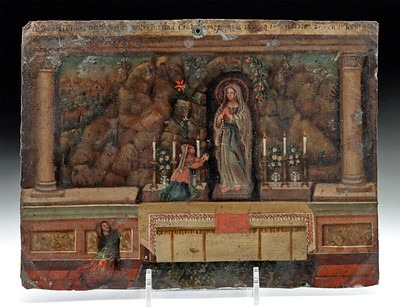Huet Toile "Louis XVI Restaurateur de la Liberte" 1789
Lot 178
About Seller
Artemis Gallery
686 S Taylor Ave, Ste 106
Louisville, CO 80027
United States
Selling antiquities, ancient and ethnographic art online since 1993, Artemis Gallery specializes in Classical Antiquities (Egyptian, Greek, Roman, Near Eastern), Asian, Pre-Columbian, African / Tribal / Oceanographic art. Our extensive inventory includes pottery, stone, metal, wood, glass and textil...Read more
Estimate:
$1,600 - $2,400
Absentee vs Live bid
Two ways to bid:
- Leave a max absentee bid and the platform will bid on your behalf up to your maximum bid during the live auction.
- Bid live during the auction and your bids will be submitted real-time to the auctioneer.
Bid Increments
| Price | Bid Increment |
|---|---|
| $0 | $25 |
| $300 | $50 |
| $1,000 | $100 |
| $2,000 | $250 |
| $5,000 | $500 |
| $10,000 | $1,000 |
| $20,000 | $2,500 |
| $50,000 | $5,000 |
| $100,000 | $10,000 |
| $200,000 | $20,000 |
About Auction
By Artemis Gallery
Jun 15, 2023
Set Reminder
2023-06-15 10:00:00
2023-06-15 10:00:00
America/New_York
Bidsquare
Bidsquare : VARIETY Ancient, Ethno, Native American, Fine Art
https://www.bidsquare.com/auctions/artemis-gallery/variety-ancient-ethno-native-american-fine-art-12990
Antiquities, ethnographic, native american and fine art from cultures encompassing the globe. Artemis Gallery info@artemisgallery.com
Antiquities, ethnographic, native american and fine art from cultures encompassing the globe. Artemis Gallery info@artemisgallery.com
- Lot Description
Designer: Jean-Baptiste Huet (French, 1745-1811). Maker: Christophe-Philippe Oberkampf (naturalized French, 1738-1815), Oberkampf & Cie. (French, 1760-1843). "Louis XVI Restaurateur de la Liberte" copper plate printed on plain-weave cotton, 1789-1791. A splendid toile de Jouy entitled "Louis XVI Restaurateur de la Liberte" designed by Jean-Baptiste Huet and printed by Christophe-Philippe Oberkampf of Oberkampf & Cie. between 1789 and 1791. Made at the heart of the French Revolution, this textile was an unsuccessful propaganda attempt by the King Louis XVI of France. The intended message is announced on a banderole held aloft by a cherub: Louis XVI is the Restorer of Liberty, a title briefly bestowed on him by the French National Assembly. The crownless king is shown holding a sword and the balanced scales of justice. Presenting him is the allegorical figure of Liberty with a pike - the weapon of the National Guard - topped by a Phrygian cap symbolizing freedom. Size of toile: 26.5" W x 14.25" H (67.3 cm x 36.2 cm); of frame: 28.5" W x 16.25" H (72.4 cm x 41.3 cm)
Below the king, the French cock dominates the British lion. During this period, the cock, viewed as a proud and courageous animal, was frequently used as a patriotic emblem for the French people. In revolutionary imagery, the bird calls for the dawn of a new era. In 1791 and 1792, the cock appeared on a coin alongside Louis XVI, in lieu of the royal fleur-de-lys.
Approaching the king are soldiers in antique dress and a young man wearing the citizen's tricorn, who present the newly drafted civil constitution to the royal. The figure of Hermes (or Mercury) stands behind them, serving to broker the negotiations. Despite such overwrought imagery, Louis XVI lost his title as Restorer of Liberty, and lost his head to the guillotine on January 21, 1793.
Founded in 1760 by Christophe-Philippe Oberkampf, the Jouy factory had become a royal manufacturer in 1783 and four years later was awarded a patent of nobility by Louis XVI. In order to stimulate sales and appeal to capricious consumer taste, the factory drew on current events for the subjects of new designs.
Additional fabric furnishing fabric prints of this design can be found at the Art Institute of Chicago (1980.484) and Cooper Hewitt, Smithsonian Design Museum (1995-50-37-a,b).
Provenance: private Rancho Mirage, California, USA collection, by inheritance in 2020; ex-Dr. TDR Berreth, California, USA, acquired before 1982
All items legal to buy/sell under U.S. Statute covering cultural patrimony Code 2600, CHAPTER 14, and are guaranteed to be as described or your money back.
A Certificate of Authenticity will accompany all winning bids.
We ship worldwide and handle all shipping in-house for your convenience.
#179146Part of a larger toile. Some light fading to pigments, but imagery is still very clear. Otherwise, in overall excellent condition with nice remaining detail. Fit in a modern frame with some nicks to frame and suspension wire on verso for display.Condition
- Shipping Info
-
All shipping is handled in-house for your convenience. Your invoice from Artemis Gallery will include shipping calculation instructions. If in doubt, please inquire BEFORE bidding for estimated shipping costs for individual items.
-
- Buyer's Premium



 EUR
EUR CAD
CAD AUD
AUD GBP
GBP MXN
MXN HKD
HKD CNY
CNY MYR
MYR SEK
SEK SGD
SGD CHF
CHF THB
THB













